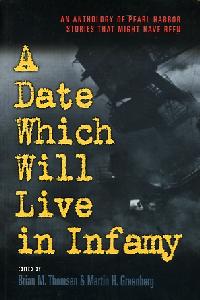A Date Which Will Live in Infamy
Alternative Pearl Harbor stories
By William Wetherall
First posted 17 July 2006
Last updated 17 July 2006

Brian M. Thomsen and Martin H. Greenberg (editors) This collection includes twelve fictional stories of the "alternative history" kind, and five articles -- an Introduction, a Postscript, and three Appendixes -- of commentary and background. The back cover features this blurb.
ContentsThe line-up of stories and authors is impressive. INTRODUCTION When Interesting History Makes Bad Hollywood / Brian M. Thomsen PART 1: ALTERNATE ARCHITECTS 1. "The Sumter Scenario: A Time Wars Story" -- Simon Hawke 2. "The Secret History of Mr. Churchill's Revenge" -- Tony Geraghty 3. "Cain" -- Jim DeFelice 4. "Pariah" -- Ed Gorman PART 2: ALTERNATE ACTIONS 5. "Green Zeroes" -- R. J. Pineiro 6. "The East Wind Caper" -- James Reasoner 7. "Path of the Storm" -- William C. Dietz 8. "The Fourth Scenario" -- William Hallahan PART 3: ALTERNATE AFTERMATHS 9. "Victory at Pearl Harbor" -- Brendan DuBois 10. "I Relieve You, Sir" -- Barrett Tillman 11. "Beer, Betrayal, and Ho Chi Minh" -- Doug Allyn 12. "A Terrible Resolve" -- William H. Keith, Jr. POSTSCRIPT December 7th, 2001: A Classroom on the American Continent / Allen C. Kupfer APPENDIX A Pearl Harbor, December 7, 1941: A Timeline / Roland Green APPENDIX B The Diplomatic Subtext of the Pearl Harbor Attack / Paul A. Thomsen APPENDIX C The Realities of an Alternate Pearl Harbor / William R. Forstchen History that strains credibilityBrian M. Thomsen begins his introduction with a list of plot twists all beginning "Imagine . . . ." If this were the scenario of a movie, the audience would groan. Movie goers would enjoy the nonsense then pick it apart. Things like that don't happen in real life. But the scenario he proposes actually happened at Pearl Harbor (page 12).
Thomsen's reminder that "truth can be stranger than fiction, and sometimes good history can make bad Hollywood" (page 13) may be a dull way to conclude an introduction to a collection of highly entertaining and thought-provoking imaginative stories "devoted to looking at some of these historically less-than-credible alternatives to the events of December 7 or their cause or outcome" (page 12). But Thomsen is right to insist that "It is always better to know what actually happened before pondering what might haven [sic] been" (page 13). And in this regard, he and Martin H. Greenberg have have gone out of their way to provide readers with fairly credible summaries of the "realities" of what actually happened at Pearl Harbor. (WW) |